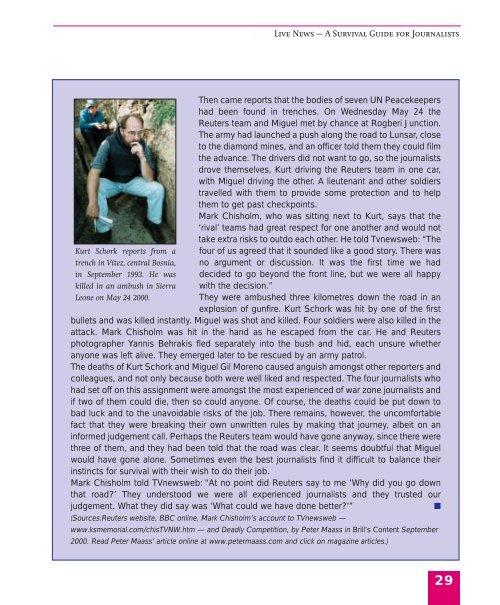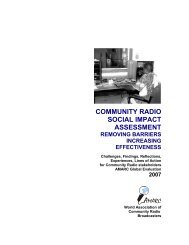Live News - A Survival Guide - International Federation of Journalists
Live News - A Survival Guide - International Federation of Journalists
Live News - A Survival Guide - International Federation of Journalists
- No tags were found...
Create successful ePaper yourself
Turn your PDF publications into a flip-book with our unique Google optimized e-Paper software.
<strong>Live</strong> <strong>News</strong> — A <strong>Survival</strong> <strong>Guide</strong> for <strong>Journalists</strong>Kurt Schork reports from atrench in Vitez, central Bosnia,in September 1993. He waskilled in an ambush in SierraLeone on May 24 2000.Then came reports that the bodies <strong>of</strong> seven UN Peacekeepershad been found in trenches. On Wednesday May 24 theReuters team and Miguel met by chance at Rogberi Junction.The army had launched a push along the road to Lunsar, closeto the diamond mines, and an <strong>of</strong>ficer told them they could filmthe advance. The drivers did not want to go, so the journalistsdrove themselves, Kurt driving the Reuters team in one car,with Miguel driving the other. A lieutenant and other soldierstravelled with them to provide some protection and to helpthem to get past checkpoints.Mark Chisholm, who was sitting next to Kurt, says that the‘rival’ teams had great respect for one another and would nottake extra risks to outdo each other. He told Tvnewsweb: “Thefour <strong>of</strong> us agreed that it sounded like a good story. There wasno argument or discussion. It was the first time we haddecided to go beyond the front line, but we were all happywith the decision.”They were ambushed three kilometres down the road in anexplosion <strong>of</strong> gunfire. Kurt Schork was hit by one <strong>of</strong> the firstbullets and was killed instantly. Miguel was shot and killed. Four soldiers were also killed in theattack. Mark Chisholm was hit in the hand as he escaped from the car. He and Reutersphotographer Yannis Behrakis fled separately into the bush and hid, each unsure whetheranyone was left alive. They emerged later to be rescued by an army patrol.The deaths <strong>of</strong> Kurt Schork and Miguel Gil Moreno caused anguish amongst other reporters andcolleagues, and not only because both were well liked and respected. The four journalists whohad set <strong>of</strong>f on this assignment were amongst the most experienced <strong>of</strong> war zone journalists andif two <strong>of</strong> them could die, then so could anyone. Of course, the deaths could be put down tobad luck and to the unavoidable risks <strong>of</strong> the job. There remains, however, the uncomfortablefact that they were breaking their own unwritten rules by making that journey, albeit on aninformed judgement call. Perhaps the Reuters team would have gone anyway, since there werethree <strong>of</strong> them, and they had been told that the road was clear. It seems doubtful that Miguelwould have gone alone. Sometimes even the best journalists find it difficult to balance theirinstincts for survival with their wish to do their job.Mark Chisholm told TVnewsweb: “At no point did Reuters say to me ‘Why did you go downthat road?’ They understood we were all experienced journalists and they trusted ourjudgement. What they did say was ‘What could we have done better?’”■(Sources:Reuters website, BBC online, Mark Chisholm’s account to TVnewsweb —www.ksmemorial.com/chisTVNW.htm — and Deadly Competition, by Peter Maass in Brill’s Content September2000. Read Peter Maass’ article online at www.petermaass.com and click on magazine articles.)29
















